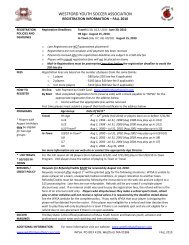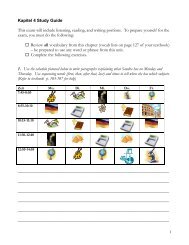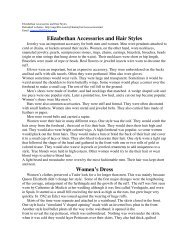Overview of an Elizabethan Outfit
Overview of an Elizabethan Outfit
Overview of an Elizabethan Outfit
Create successful ePaper yourself
Turn your PDF publications into a flip-book with our unique Google optimized e-Paper software.
Putting on <strong>an</strong> Elizabeth<strong>an</strong> <strong>Outfit</strong><br />
Defunked website= http://www.dnaco.net’—aleed/corsets/overview.html<br />
<strong>Overview</strong> <strong>of</strong> <strong>an</strong> Elizabeth<strong>an</strong> <strong>Outfit</strong><br />
Or “She must be stifling in that thing”<br />
This is a listing <strong>of</strong> the main elements <strong>of</strong> Elizabeth<strong>an</strong> costume. (By the term “Elizabeth<strong>an</strong>”, I<br />
me<strong>an</strong> the dress worn by the English approximately during Queen Elizabeth’s reign (1560-<br />
1600). Each item is accomp<strong>an</strong>ied by a short definition <strong>an</strong>d expl<strong>an</strong>ation accomp<strong>an</strong>ying each item<br />
as well as pointers to more detailed information elsewhere at this site.<br />
Even when one doesn’t take into account the variations in style between 1550 <strong>an</strong>d 1590, <strong>an</strong>d the<br />
radical spectrum <strong>of</strong> fashion occurring between the middling poor <strong>an</strong>d nobility, there is a<br />
bewildering variety in English Elizabeth<strong>an</strong> womenswear--French gowns, round gowns, loose<br />
gowns, night gowns, doublets, Itali<strong>an</strong> gowns, <strong>an</strong>d Flemish <strong>an</strong>d Polish gowns, just for starters.<br />
So this is a general listing, not a specific one, concentrating mainly on the under-clothing worn<br />
by middle- <strong>an</strong>d upper- class Englishwomen in the latter half <strong>of</strong> the 16th century to create the<br />
Elizabeth<strong>an</strong> silhouette.<br />
Putting on <strong>an</strong> English Elizabeth<strong>an</strong> gown is a complicated process, <strong>an</strong>d when you include hair<br />
<strong>an</strong>d makeup, c<strong>an</strong> take half <strong>an</strong> hour or more.<br />
Any undies, stockings, shoes, earrings, etc. go on first. Dress your hair <strong>an</strong>d do your makeup<br />
before starting; once you’re dressed, it’ll be nearly impossible. Although Elizabeth<strong>an</strong> women<br />
didn’t wear underwear per Se, they did wear stockings. These usually came to just above the<br />
knee, <strong>an</strong>d were held in place by a garter at the top <strong>of</strong> the calf. See Knitting Period Stockings for<br />
more details.<br />
There is evidence that Englishwomens’ shoes during Elizabeth<strong>an</strong> times were usually thin-soled<br />
with leather soles, <strong>an</strong>d had uppers <strong>of</strong> leather, velvet or other fabrics lined (by the nobility, at<br />
least) with scarlet, taffeta, or satin. They were for the most part simple, slipper-type shoes, cut<br />
low on the top <strong>an</strong>d round-toed, although heeled shoes became more popular from the 1 560s<br />
onward. For more information, here’s a site containing Patterns for Tudor Shoes.<br />
To protect their shoes from the muck <strong>an</strong>d mud <strong>of</strong> <strong>an</strong> average English street, women wore<br />
pattens, or chopines. Pattens were wooden soles, usually 1/2 to 1 inch thick, hinged at the ball<br />
<strong>of</strong> the foot with leather straps that were strapped on over the shoes, rather like s<strong>an</strong>dals.<br />
Chopines, also called p<strong>an</strong>tobles or mules, r<strong>an</strong>ged from sturdy-soled shoes with heels to high,<br />
discoesque platforms.<br />
Put on your Chemise/smock. This was a simple underdress worn to protect the<br />
clothing from sweat <strong>an</strong>d body oils. It <strong>of</strong>ten had full sleeves gathered to a cuff, <strong>an</strong>d<br />
either gathered to a neckb<strong>an</strong>d or fitted close to the chest, although examples exist<br />
<strong>of</strong> ungathered smocks. For more information on the history <strong>an</strong>d variety <strong>of</strong><br />
Elizabeth<strong>an</strong> smocks, see the section on Elizabeth<strong>an</strong> Smocks <strong>an</strong>d Chemises
If you’re going to wear <strong>an</strong> under-petticoat under your farthingale to keep warm <strong>an</strong>d to prevent<br />
<strong>an</strong>y flashes <strong>of</strong> leg, put that on now. Petticoats were underskirts worn both for decoration (<strong>of</strong>ten<br />
<strong>an</strong> overskirt would be tucked up to display a pretty underskirt) <strong>an</strong>d for warmth. Decorated<br />
petticoats were worn over a farthingale <strong>an</strong>d buniroll (see the next two sections), but fl<strong>an</strong>nel<br />
under-petticoats are also documented as being worn underneath the farthingale. The tailors’<br />
patterns <strong>of</strong> the time, <strong>an</strong>d surviving petticoats <strong>an</strong>d skirts, most commonly show slightly gored or<br />
flared pieces gathered or pleated to a waistb<strong>an</strong>d. For more information on petticoats, visit this<br />
page on Elizabeth<strong>an</strong> Petticoats<br />
Put on your farthingale/hoop skirt. The Sp<strong>an</strong>ish farthingale, worn from<br />
approximately 1540-1580, was a cone-shaped underskirt stiffened with willow<br />
osiers or other materials. The design for this farthingale was imported from<br />
Spain; hence the name. It was this undergarment which created the signature<br />
early Elizabeth<strong>an</strong> A-line skirt. As the century w<strong>an</strong>ed, it gradually gave way to<br />
the French Farthingale, which had a different look altogether. For more info on<br />
the farthingale <strong>an</strong>d its evolution throughout the Elizabeth<strong>an</strong> era, look at the<br />
sections on the History <strong>of</strong> the Farthin2ale <strong>an</strong>d Making Elizabeth<strong>an</strong> Farthingales.<br />
The corset/pair <strong>of</strong> bodies. This was a close-fitting stiffened garment, usually<br />
with a wooden busk down the front to make it flatter <strong>an</strong>d stiffer. The pair <strong>of</strong><br />
bodies, or some comparative type <strong>of</strong> stiffening, is essential for all middle class<br />
<strong>an</strong>d upper class Elizabeth<strong>an</strong> gowns; even if you have a beautiful bodice <strong>an</strong>d<br />
sleeves, the period effect will be ruined by the torso’s natural lumps <strong>an</strong>d bulges<br />
if you go without a corset, unless the bodice itself is heavily boned (in which<br />
case it is itself called a pair <strong>of</strong> bodies--you have to love period terminology).<br />
Look at the sections on the History <strong>of</strong> the Elizabeth<strong>an</strong> Corset, Corset Materials,<br />
Corset Patterns <strong>an</strong>d Sewing a Corset Together to find out more about this garment.<br />
Put on your bumroll. The bumroll, worn by almost all Elizabeth<strong>an</strong> women <strong>of</strong><br />
<strong>an</strong>y me<strong>an</strong>s, was a round, crescent-shaped pad that makes the skirt stick out like<br />
it should. Look at Making <strong>an</strong> Elizabeth<strong>an</strong> Bumroll for more information.<br />
If you have a partlet, this goes on now. The partlet was a curious item <strong>of</strong><br />
clothing worn by Tudor <strong>an</strong>d Elizabeth<strong>an</strong> women which covered only the front<br />
<strong>an</strong>d back chest <strong>an</strong>d tied under the arms. Originally it was worn over a dress,<br />
but by the mid 16th century it was, for the most part, worn over the corset <strong>an</strong>d<br />
under the bodice.






